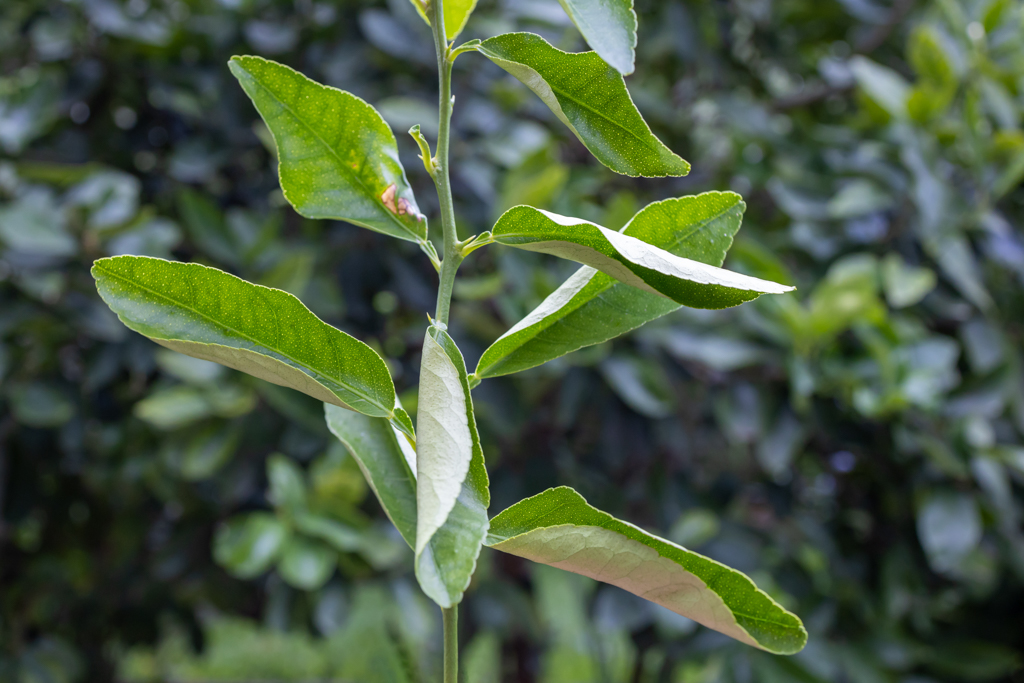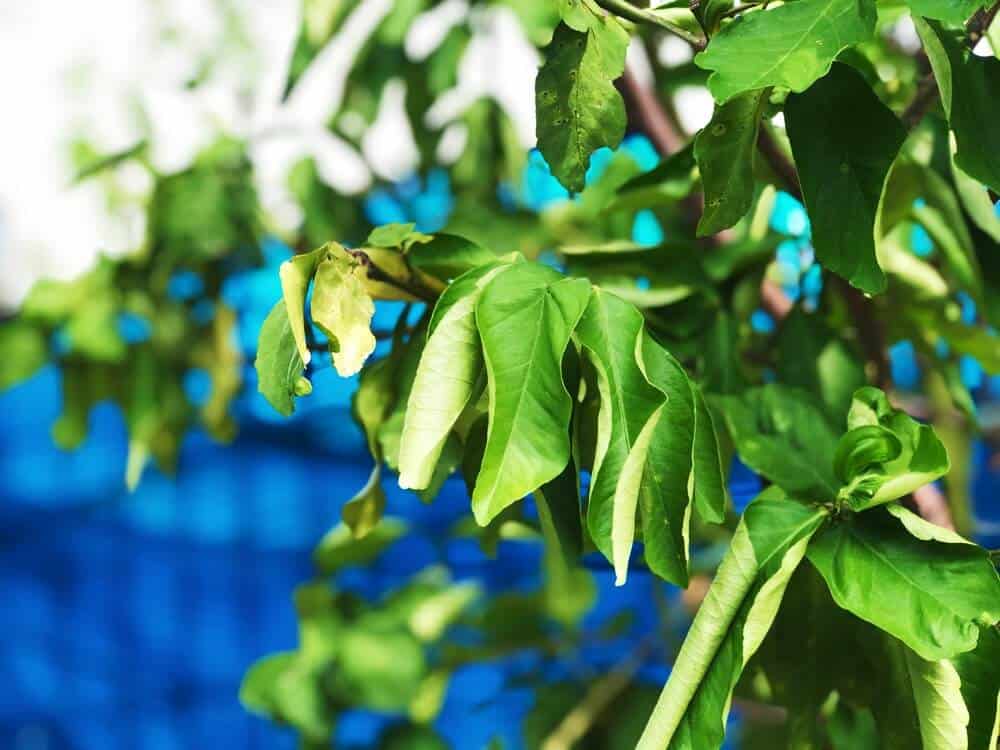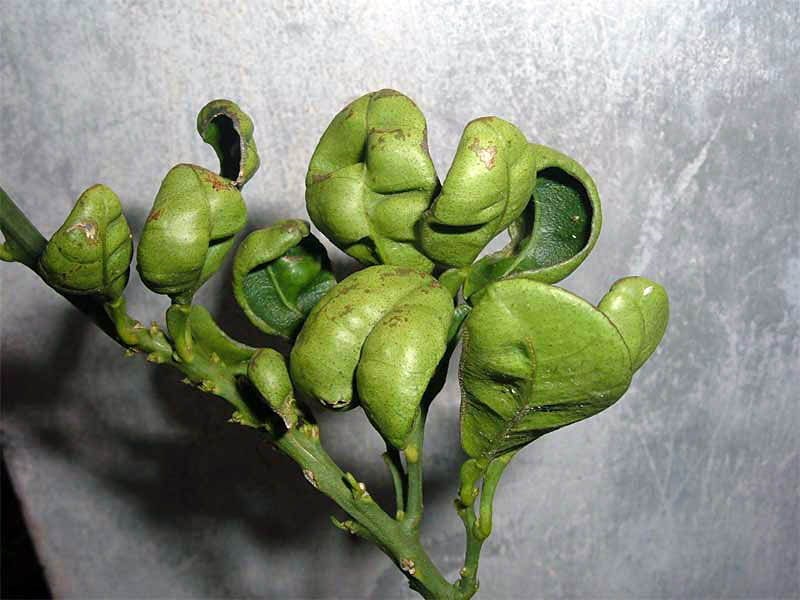
Drought causes the leaves of lemon trees to curl. Excessive wind, low humidity, and insufficient watering all dehydrate the leaves, causing them to curl in an effort to retain moisture. Infestations of aphids cause leaves to curl because they feed on the sap of newly growing leaves.
While nutrient deficient soil, transplant shock from moving lemon trees indoors, and even overwatering can cause leaves to curl often with yellowing of foliage and leaf drop on your lemon tree, drought stress is the most prevalent cause.
Learn what causes curling leaves, how to avoid it, and how to revitalize your lemon tree by reading on.
Table of Contents
Under Watering is the Most Common Cause of Curling Leaves
Most frequently, leaves that appear withered and curled show that a lemon tree is under drought stress.
In contrast to many other fruit trees, lemon trees actually prefer slightly dryer soil, however difficulties might arise when the soil entirely dries up or when there is excessive wind that robs the leaves of their moisture.
Lemon tree leaves curl because:
- watering insufficiently. Lemon trees want the top two inches of the soil to become completely dry in between watering sessions before receiving a heavy soak once a week. Watering a lemon tree too sparingly prevents water from penetrating the soil and reaching the roots, which causes the leaves to curl.
- Pots dry out faster in the heat. Much more quickly than garden borders, the earth in pots dries out. Pots might hold less moisture since they can’t hold as much soil. Also lemon trees require full sun which might further increase the drying of pots and induce drought.
- too much wind Lemon trees should be protected from the wind to some extent since excessive wind speeds up moisture loss from the leaves, which is one of the faster-acting reasons of leaf curling.
Revive Lemon Trees with Curling Leaves due to Drought
Drought-damaged lemon trees with curling leaves can be resurrected with a few adjustments to the environment.
- Attempt to protect the tree from strong winds. With potted trees, the solution might be as simple as transferring the dry plants to a location with a built-in windbreak, like a spot protected by other trees or a fence. When relocating your lemon tree to a more protected area, take care not to deprive it of sunshine. If you want to protect lemon trees from the hardest winds, attempt to create a wind break with other plants.
- To reduce water loss from the leaves, mist the withered lemon tree leaves with a sprayer to raise the microclimate’s humidity level. While the lemon tree heals, mist the leaves twice daily.
- If you have lemon trees in your garden, use a soaker hose. Turn on the soaker hose and let it run for a while to thoroughly wet the ground. After a drought, it’s crucial to water the tree liberally since too much heat and sun scorch the soil, preventing water from penetrating to the roots and causing water to flow off the surface.
- The frequency of watering lemon trees in pots should be increased. Potted plants dry out more quickly, especially in direct sunlight. Lemon trees prefer the soil to be slightly dry in between waterings, however excessive heat and sun might stress them out due to drought. When the top two inches of the soil are dry, which may be twice a week or more in the summer, water as quickly as possible.
If possible, completely submerge the potted lemon plants in water—in a basin or wheelbarrow of water—for those suffering from drought.
When the pot is submerged in water, moisture can reach the roots instead of dripping off the side of the pot and down the dry soil’s surface.
The leaves of the lemon tree should straighten up during the course of the following week after receiving a thorough watering and regular misting.
In order to avoid stressing the lemon tree when it is recovering from drought on a hot day, I advise temporarily shading it.
(To find out how to determine the ideal watering frequency for your climate, read my post on how to water lemon trees.)
Indoor Lemon Tree Leaves Curling

However, certain conditions indoors have a tendency to make a lemon tree’s leaves curl and even fall off.
The following circumstances result in leaf curling in indoor lemon trees:
- lower humidity and drier air. Lemon trees prefer some humidity and are native to tropical areas. The air currents from air conditioning, forced air, and radiators that are present indoors compete with the lemon tree leaves for moisture, robbing them of it. To preserve moisture, the lemon tree responds by curling its leaves. A lemon tree frequently experiences leaf loss as a result of this.
- Temperature fluctuations are brought on by heat sources. We frequently put on the heating at home in the evenings during the winter inside. This is in opposition to the daily cycle of temperature fluctuation that an outdoor lemon tree undergoes, which leads to stress and results in curled leaves. The sources of heat also cause the soil to evaporate more quickly, which dries out the plant and causes its leaves to become shriveled.
- less lighting inside. Lemon trees enjoy full daylight, thus they frequently experience shock when exposed to reduced indoor light levels, which leads to stress.
- transfusion shock Given the stark disparity between the weather outside and within your home, lemon trees’ leaves can curl in response to a quick change in environment. The leaves curling is caused by a sharp and fast change in circumstances, such as temperature.
How to Revive an Indoor Lemon Trees with Curling Leaves
Even if some of the leaves are beginning to fall or turn yellow, indoor lemon trees in pots can survive and thrive. Addressing the moisture balance and reducing the stress of being brought indoors are crucial.
- Use a mist sprayer to mist the leaves. This is one of the best methods for reviving curled leaves since it successfully raises humidity levels to mimic the circumstances desired by lemon trees. To keep the leaves moist while they adjust to your home and to reduce water loss from the foliage, mist them with water as much as twice daily.
- Make sure the lemon tree is not directly exposed to forced air or air conditioning. The lemon tree ought to be placed in a bright window that is away from air currents. The leaves get regular misting.
- Increase the watering schedule. Lemon trees are accustomed to being watered frequently outside, but when brought indoors, their thirst for water rises, causing the leaves to curl as a sign of stress. Due to their slower pace of growth, lemon trees like the top two inches of the soil to dry out between waterings in the winter. However, excessive heat indoors can accelerate evaporation and cause the pot to dry out more quickly. When the top two inches of the soil are dry, give the tree a good soak, and check the soil moisture levels frequently.
- Give your lemon tree some time to get used to being inside. The stress of being brought indoors stresses out the lemon tree, but as long as it is placed in a sunny window, hydrated appropriately for its needs, and regularly sprayed with water, it should recover.
Lemon trees do this to conserve moisture, thus some leaves may fall off after they curl up.
If the tree is properly cared for, do not be alarmed if this occurs because new leaves will appear in the Spring in response to longer hours of light.
(Leaves from lemon trees can fall off for a variety of reasons; I prepared another post on the causes and remedies for leaf loss in lemon trees.)
Over Watering Causes Lemon Tree Leaves to Curl and Droop
Lemon trees are more tolerant of overwatering than the majority of fruit trees and prefer dryer soil conditions. Overwatering can also cause leaves to curl as a symptom of stress.
Curling leaves from dehydration typically have a shriveled appearance, whereas curling leaves from overwatering may lose their green hue and appear a little bit yellow.
(I published another post on what causes lemon tree leaves to turn yellow because yellow leaves on your lemon tree might signify various problems.)
Lemon plants enjoy slightly dry top two inches of soil between waterings and need soil that drains effectively.
Overwatering and excessive moisture near the roots cause lemon tree leaves to curl when:
- excessive watering caused the soil to remain wet all the time. The leaves typically curl and turn yellow as an indication of stress if the soil is moist. Additionally, moist soil fosters the growth of fungi that cause illnesses like root rot, which can be fatal to lemon trees.
- soils that drain slowly. Lemon trees do not thrive in swampy soil or clay with a high water retention capacity. They naturally flourish in soil that drains well, has a high proportion of organic matter, and may contain some inorganic material like grit for better drainage. Slow-draining soils have a similar effect to overwatering in that they cause the leaves to curl, turn yellow, and maybe develop root rot.
- pots with holes for drainage in the bottom. Insufficient drainage holes in the base of some decorative pots lead the soil to become saturated, which in turn causes the leaves to curl, turn yellow, and possibly drop off as a sign of stress.
- trays under indoor lemon trees in pots. Trays under pots prevent extra moisture from evaporating, resulting in soggy soil that stresses your lemon tree.
How to Revive Lemon Trees with Leaves Curling due to Over watering
- Restrict the irrigation. When the top two inches of soil are no longer moist, water your lemon tree. Typically, this occurs once a week, but you should decide how frequently to water your lemon tree based on the environment and weather in your area. Give the lemon tree a good soak once the soil has dried to a depth of a few fingers.
- Lemon trees need to be grown on soils that drain properly. If your tree is in a wet region, you should move it to a more well-draining area of the garden as soon as possible to prevent the lemon tree from dying back. For growing lemon trees, an excellent potting mix or soil formula is composed of 1/3 garden compost, 1/3 multipurpose compost, and 1/3 horticultural grit, sand, or perlite. This soil blend provides an excellent balance of soil nutrients and good drainage, replicating the soil characteristics of the lemon trees’ natural environment.
- Lemon trees that are cultivated in pots need to be in pots with sufficient drainage. Transfer your plant as soon as possible to another pot if your current one does not have drainage holes in the base since the plant may die and the curling leaves will turn yellow.
- Water in trays underneath pots needs to be removed on a regular basis. Trays under pots can be helpful in preventing water from your indoor lemon tree from overflowing, but water shouldn’t pool there for a long time.
The soil surrounding the roots of your lemon tree can dry out a little between waterings with better drainage and good watering techniques.
This enables the plant to recuperate and generates the ideal level of moisture for lemon trees in the soil.
In the next weeks, you ought to start noticing an improvement in the curled leaves.
The necessity of knowing how to water properly is highlighted by the fact that if the soil is left too wet, the lemon tree is likely to get the fungal illness root rot, which will cause the leaves to curl, turn yellow, and drop off and the plant to wither.
(Read my post on how to revive a lemon tree that is dying.)
Nutrient Deficient Soil causes Lemon Tree Leaves Curling
Due to their high nutritional needs, lemon trees require regular fertilizer applications in the spring and summer if they are to produce the greatest fruit and blossoms.
One of the symptoms of stress caused by nutritional deficiency is when leaves begin to curl, droop, turn yellow, and maybe drop off.
Potted plants are typically more prone to nutritional deficiencies, particularly if they have been in the same pot for a long time and the roots have used up all of the nutrients.
The precise causes of curling leaves are likely to be magnesium and potassium deficits in the soil, with leaves curling more inwards indicating magnesium and leaves curling downwards indicating potassium deficiency in the soil.
A shortage of nutrition can also cause leaves to droop and turn yellow, which may resemble a curled leaf.
Of course, you can ask for a soil test, in which case you submit a sample of your soil to a lab to find out how healthy it is.
Alternately, you can solve the nitrogen shortfall by using a citrus fertilizer.
Instead of using a general purpose fertilizer, use a specific citrus fertilizer (available at a garden store or on Amazon) since a citrus feed has all the nutrients your lemon tree needs at the proper percentages to prevent overfertilizing, which can also cause your leaves to curl downward.
The lemon leaves should start to seem much healthier rather than curled with regular monthly fertilizer applications through the Spring and Summer (always follow the manufacturers instructions).
Aphids and Spider Mites can Cause Lemon Tree Leaves to Curl

arachnid mites
If you see little yellow patches and curled leaves, you probably have a spider mite infestation.
Because they prefer the dryer atmosphere of homes, spider mites are more numerous indoors and frequently harm lemon trees that have been brought inside for the winter.
Since spider mites detest moisture and humidity, misting the leaves frequently is a very efficient way to get rid of them. Another highly efficient remedy is to wash the leaves with dishwater containing dish soap.
If you remove any really damaged foliage, the tree should recover.
Aphids…
Aphids can also be an issue since they try to eat the sap from your lemon tree, which causes the leaves to curl.
Aphid infestations on lemon trees are widespread, and they often target the younger, more delicate leaves. However, any significant damage is typically reduced by a healthy garden ecosystem.
There are numerous insect predators that target both aphids and birds, including ladybugs.
Use of an insecticide, such as neem oil, which is sprayed to the leaves of the lemon tree and kills the aphids, is the remedy for a major aphid infestation.
If lemon trees are treated for bug infestations, they typically bounce back fairly well. Curling leaves should survive if the severely harmed leaves are cut back.
Key Takeaways:
- Your lemon tree’s leaves curling suggest drought stress as a result of inadequate watering, excessive wind, and low humidity, which causes the leaves to curl to retain moisture. Aphids curl up as a result of feeding on the sap of young, developing leaves.
- Lemon tree leaves can curl due to nutrient-deficient soil, excessive watering, and transplant shock when brought indoors.
- Lemon trees need full sun, frequent fertilization, and watering when the soil’s top two inches are dry. Spraying leaves can aid in boosting humidity, which revitalizes leaves and reduces pest damage.
- To control insect infestations that may cause the leaves of lemon trees to curl, use neem oil or an insecticide.
